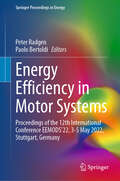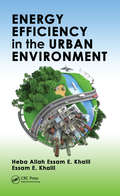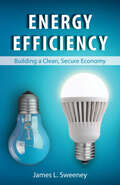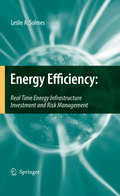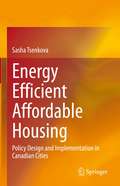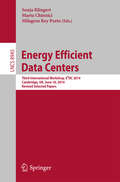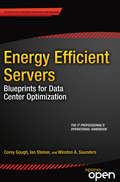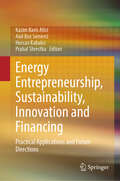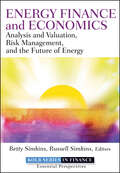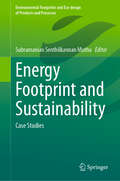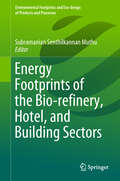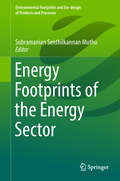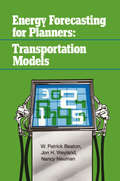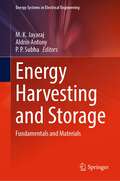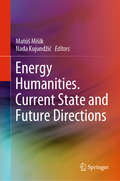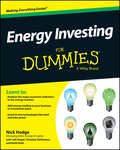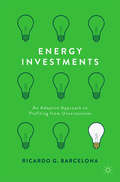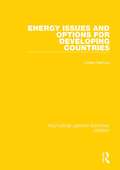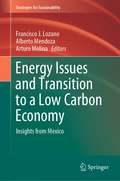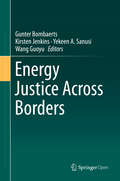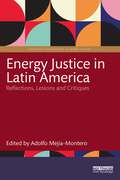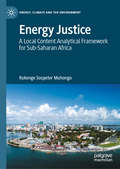- Table View
- List View
Energy Efficiency in Motor Systems: Proceedings of the 12th International Conference EEMODS’22, 3-5 May 2022, Stuttgart, Germany (Springer Proceedings in Energy)
by Peter Radgen Paolo BertoldiThis book contains selected, peer-reviewed papers presented at the 12th International Conference on Energy Efficiency in Motor Systems (EEMODS'22), held in Stuttgart, Germany from May 3-5, 2022. As with previous conferences in this series, EEMODS’22 provided a scientific forum to discuss and debate the latest developments and impacts of electrical motor systems on energy and the environment, energy efficiency policies and programs adopted and planned, standards (including ISO 50.001), and the technical and commercial advances made in the dissemination and penetration of energy-efficient motor systems. Topics covered include emerging motor technologies, research and innovation in electric motors, power electronics and drives, pump systems, market surveillance and enforcement mechanisms, national energy efficiency standards including case studies, plus much more. The conference is international by nature and aims to attract high quality and innovative contributions from all corners of the globe, while the papers facilitate the development of new technologies, policies and strategies to increase energy efficiency.
Energy Efficiency in the Urban Environment
by Heba Allah Khalil Essam E. KhalilEnergy Efficiency in the Urban Environment is a study of energy crisis, urbanisation, and climate change, as well as a discussion of how to combat these global challenges. With a special focus on Egypt, this book addresses the macroscale of urbanism from the perspective of city dwellers' quality of life, and explores the microscale of buildings and
Energy Efficiency: Building a Clean, Secure Economy
by James L. SweeneyThe entire world, especially the United States, is in the midst of an energy revolution. Since the oil embargo of 1973, individuals, corporations, and other organizations have found ways to economically reduce energy use. In this book, Jim Sweeney examines the energy policies and practices of the past forty years and their impact on three crucial systems: the economy, the environment, and national security. He shows how energy-efficiency contributions to the country's overall energy situation have been more powerful than all the increases in the domestic production of oil, gas, coal, geothermal energy, nuclear power, solar power, wind power, and biofuels. The author details the impact of new and improved energy-efficient technologies, the environmental and national security benefits of energy efficiency, ways to amplify energy efficiency, and more. Energy Efficiency: Building a Clean, Secure Economy reveals how the careful nurturing of private- and public-sector energy efficiency--along with public awareness, appropriate pricing, appropriate policies--and increased research and development, the trends of decreasing energy intensity and increasing energy efficiency can be beneficially accelerated.
Energy Efficiency: Real Time Energy Infrastructure Investment and Risk Management
by Leslie A. SolmesENERGY EFFICIENCY uses an applied scientific methodology and case studies to demonstrate and support: The need for the U.S. and the world to commit to energy and resource efficiency as the central goal in investing in electric, heat, and cooling infrastructure, the huge economic opportunity for using the inefficiency built into 20th century energy supply systems, especially, electric, to pay for the upgrades, replacements, and new production and distribution systems of the 21st century, the importance of adopting a standard, web-based energy infrastructure investment decision-making and risk management tool that will serve as a communication medium for all stakeholders to evaluate and compare energy infrastructure investment options and manage investment risks, expansions of the U.S. 'smart' grid investment to include evaluation and risk management of energy systems infrastructure investments not just electricity operations, the need to adopt a 'framework' for utilities, energy service companies, and customers to work together to close business deals, communicate and manage risks, and realize profits.
Energy Efficient Affordable Housing: Policy Design and Implementation in Canadian Cities
by Sasha TsenkovaThis book provides the first comparative assessment of the energy-efficiency retrofit programs in the social housing sector of Canadian cities, focusing on program efficiency and effectiveness. The analytical framework explores key policy instruments - regulatory, fiscal and institutional - in relation to major results achieved. The approach is interdisciplinary, supported by rich empirical data from case studies, observations and interviews. The book explores important strategies for the provision of green and affordable housing, while addressing climate change imperatives and resilience issues. This is of great interest to researchers, policy makers, city leaders, professionals and students. Its value added contribution to scholarship is complemented by practical relevance for social housing organisations in countries with a small residual housing sector. It offers valuable lessons for the design, planning and implementation of energy retrofit programs in North America and beyond.
Energy Efficient Cities: Assessment Tools and Benchmarking Practices
by Ranjan K. BoseUrban areas account for two-thirds of global energy requirements while housing approximately half of the world's population. With current projections indicating that 70 percent of the world's population will live in cities by 2050, an increase in urban energy use is inevitable. In the face of this growing energy demand, developing climate-friendly urban energy solutions, while protecting the urban development that is crucial to socioeconomic progress in developing countries, is imperative. In an effort to catalyze solutions that would delink high levels of carbon-intensive energy use from urban growth, the Energy Sector Management Assistance Program (ESMAP) of the World Bank launched the Energy Efficient Cities Initiative in October 2008. 'Energy Efficient Cities: Assessment Tools and Benchmarking Practices' is a product of that initiative. The analytical tools and policy insights offered in this volume extend from integrated assessments of new cities to the impacts of socioeconomic, climate, and demographic changes on existing cities. In addition, the documentation and benchmarking of a variety of low-carbon and carbon-neutral good practices provide a range of practical insights on plausible energy efficient interventions in urban sectors. This book will be of particular interest to policy makers, development practitioners, and decision makers in the private sector, as well as researchers within nongovernmental organizations and the academic community.
Energy Efficient Data Centers
by Sonja Klingert Marta Chinnici Milagros Rey PortoThis book constitutes the thoroughly refereed post-conference proceedings of the Third International Workshop on Energy Efficient Data Centers, E2DC 2014, held in Cambridge, UK, in June 2014. The 10 revised full papers presented were carefully selected from numerous submissions. They are organized in three topical sections named: energy optimization algorithms and models, the future role of data centres in Europe and energy efficiency metrics for data centres.
Energy Efficient Servers: Blueprints for Data Center Optimization
by Corey Gough Ian Steiner Winston SaundersEnergy Efficient Servers: Blueprints for Data Center Optimization introduces engineers and IT professionals to the power management technologies and techniques used in energy efficient servers. The book includes a deep examination of different features used in processors, memory, interconnects, I/O devices, and other platform components. It outlines the power and performance impact of these features and the role firmware and software play in initialization and control. Using examples from cloud, HPC, and enterprise environments, the book demonstrates how various power management technologies are utilized across a range of server utilization. It teaches the reader how to monitor, analyze, and optimize their environment to best suit their needs. It shares optimization techniques used by data center administrators and system optimization experts at the world's most advanced data centers. What you'll learn * Develop a deep understanding of power management in modern servers - from data center and systems software to low-level processor technologies - and all the pieces in-between. * Build an understanding of technologies used in cores, caches, memory, system agents, processor interconnects, and PCI-E to manage power. * Learn techniques for monitoring and characterizing server power management technologies including component and system level impact. * Develop strategies to improve infrastructure utilization and cost-effectiveness, to guide configuration and purchasing decisions, and to enhance application deployment. * Learn new techniques to optimize a server for energy efficiency while still meeting the service level requirements of software, related systems in the data center, and end customers. Who this book is for Primarily: Engineers and IT professionals. More broadly, the book appeals to a wide technologist audience - anyone who designs or relies on a server to run services and applications - from software engineers, to system administrators, to equipment and system manufacturers, to data center operators. Table of Contents Foreword/Preface Chapter 1: Why Data Center Efficiency Matters Chapter 2: CPU and Memory Power Management Chapter 3: Memory and I/O Power Management Chapter 4: Software Architecture Chapter 5: BIOS and Management Firmware Chapter 6: Operating Systems Chapter 7: Monitoring Chapter 8: Characterization and Optimization Chapter 9: Data Center Management Chapter 10: Terms and Technology Appendix
Energy Entrepreneurship, Sustainability, Innovation and Financing: Practical Applications and Future Directions
by Kazim Baris Atici Anil Boz Semerci Hurcan Kabakci Prabal ShresthaThis book aims to contribute to both academic and practitioner sides of the energy sector by offering entrepreneurial applications followed by various sustainability impacts of the sector. The contributions by a group of researchers provide a fruitful research setting to explore the impact of institutions and policies on the innovation process in the energy sector. The content is divided into three main parts: Part A: Conceptual Foundations of Energy Entrepreneurship and Sustainability, Part B: Institutional and Environmental Issues in Energy Entrepreneurship, and Part C: Operational and Financial Issues in the Energy Sector. The book appeals to scholars in management, entrepreneurship, economics, finance, and operations research and to practitioners working in the energy sector. This is the 10th volume in a series on energy organized by the Center for Energy and Value Issues (CEVI). For this volume, CEVI collaborates with Hacettepe University IDEAL (Innovator, Dreamer, Entrepreneur, Achiever, Learner) and Hacettepe University Energy Markets Research & Application Center. The previous volumes in the series are: Financial Aspects in Energy (2011), Energy Economics and Financial Markets (2012), Perspectives on Energy Risk (2014), Energy Technology and Valuation Issues (2015), Energy and Finance (2016), Energy Economy, Finance and Geostrategy (2018), Financial Implications of Regulations in the Energy Industry (2020), Applied Operations Research and Financial Modelling in Energy (2021), and The ESG Framework and the Energy Industry (2023).
Energy Finance
by Betty Simkins Russell SimkinsThought leaders and experts offer the most current information and insights into energy financeEnergy Finance offers the most up-to-date information and compelling insights into the finance and economics of energy. With contributions from today's thought leaders who are experts in various areas of energy finance and economics, the book provides an overview of the energy industry and addresses issues concerning energy finance and economics.The book focuses on a range of topics including corporate finance relevant to the oil and gas industry as well as addressing issues of unconventional, renewable, and alternative energy.A timely compendium of information and insights centering on topics related to energy financeWritten by Betty and Russell Simkins, two experts on the topic of the economics of energyCovers special issues related to energy finance such as hybrid cars, energy hedging, and other timely topicsIn one handy resource, the editors have collected the best-thinking on energy finance.
Energy Footprint and Sustainability: Case Studies (Environmental Footprints and Eco-design of Products and Processes)
by Subramanian Senthilkannan MuthuThis volume orients readers to the concept of energy footprints and their implications for sustainability and offers several cases that illustrate this concept. Significantly, a detailed review chapter presents a of models and methods for measurement of energy footprints across different industrial sectors. Following this, case study chapters from India and the United States offer demonstrations of the application of the described principles. The metrics and indicators described here and means to assess them offer powerful tools for organizations to work toward sustainability and the achievement of the United nations seventeen Sustainable Development Goals.
Energy Footprints of the Bio-refinery, Hotel, and Building Sectors (Environmental Footprints And Eco-design Of Products And Processes)
by Subramanian Senthilkannan MuthuThis book deals with the energy footprints of biorefineries and the hotel and buildings sector. It presents footprint case studies, which include background information, methodological frameworks, assessment checklists, calculation tools and techniques, applications, challenges and limitations. It also discusses the application of each indicator/framework in various industrial sectors and the associated challenges, along with outlooks for the future. Consumption and conservation of energy are key elements in any industry’s sustainability strategy.
Energy Footprints of the Energy Sector (Environmental Footprints And Eco-design Of Products And Processes)
by Subramanian Senthilkannan MuthuThis book examines the energy footprints of various industrial sectors, including the bio- and hydrogen energy systems, and explores the scope for improvement, particularly in India. It focuses on the consumption and conservation of energy, which are the key elements of any industry’s sustainability strategy.
Energy Forecasting for Planners
by Jon H. WeylandWith the increased public awareness of a deepening energy crisis, governments at all levels have begun to examine their ability to act meaningfully in response to forms of short- and long-term energy-related political pressures. Emergency preparedness, conservation programs, and contingency planning have become watchwords in our new energy bureaus.
Energy Futures: The Story of Fossil Fuel, Greenhouse Gas, and Climate Change
by Daniel J. SoederThe second edition of this book updates some of the progress in clean energy and climate tech that has been made since the initial publication in 2022 and adds new material that was not available earlier, including information on energy from hydrogen, recent developments in geothermal technology, and progress on carbon dioxide removal. It also discusses changes in international climate policies, including a greater focus on loss and damage in the Global South and some restructuring of carbon offset economics in both North America and Europe. The objective of this book is to help the average, concerned reader better understand the links between fossil fuel, greenhouse gas, and climate change in a clear, explanatory format. It avoids sensationalism and politics, using plain language to explain the details of the science, how the science works, and how we know what we know. The book is referenced throughout with footnotes. It describes the history of fossil fuels, why fossil fuel combustion products are a problem, and what must be done to address the impacts on climate. Details include a number of energy engineering solutions to replace fossil fuels with renewable, clean energy, and information about a technology called geoengineering that can cool the planet and directly remove greenhouse gases from the atmosphere. Many people are pessimistic about the future and prepared to give up on addressing climate change. This book strives to maintain hope that humanity can and must solve this and other environmental problems. The climate crisis was caused by humans, and it can be addressed with human engineering. Responsible discussions by informed readers with their political leaders are a pathway for implementing solutions to climate change.
Energy Guide: A Directory of Information Resources (Routledge Library Editions: Energy)
by Virginia BemisOriginally published in 1977. This annotated guide to sources of information on the social science aspects of energy and energy alternatives describes materials and sources of interest to users at all levels. The chapters separate information according to the type of material or the issuing organization. The index classifies according to type of energy, or energy issue. The final chapter is a special section of listings of empirical social science studies on energy and the energy crisis which contain detailed annotation on the methods, variables and findings. Those research projects cover attitudes, behavior, costs, policy and other energy-related matters.
Energy Harvesting and Storage: Fundamentals and Materials (Energy Systems in Electrical Engineering)
by M. K. Jayaraj Aldrin Antony P. P. SubhaThis book covers recent technologies developed for energy harvesting as well as energy storage applications. The book includes the fabrication of optoelectronic devices such as high-efficiency c-Si solar cells, carrier selective c-Si solar cells, quantum dot, and dye-sensitized solar cells, perovskite solar cells, Li-ion batteries, and supercapacitors. Aiming at beginners in the respective areas, the basic principles and mechanism of the optoelectronic phenomena behind every application are detailed in the book. The book offers schematics, tables, graphical representations, and illustrations to enable better understanding. Among the nine chapters, the first four chapters are dedicated to various types of high-efficiency solar cells and the remaining chapters discuss the methods for energy storage such as the fabrication of batteries and supercapacitors. The book is a useful reference for active researchers and academicians working in energy harvesting and energy storage areas.
Energy Humanities. Current State and Future Directions
by Matúš Mišík Nada KujundžićThis edited book explicitly deals with the energy humanities, summarising existing knowledge in the area and outlining possible future directions for the nascent field. Assuming a variety of disciplinary stances and using a plethora of methodologies to address a number of pressing energy-related issues, the individual contributions showcase the crucial importance of including the humanities and social sciences into the current discussion on energy. Furthermore, they illustrate one of the central claims of the energy humanities, namely, that energy permeates all aspects of our contemporary modes of existence, and is inextricably linked with historical, political, social, ideological, and cultural issues, relationships, and practices.Through numerous case studies, Energy Humanities and Energy Transition looks to the past, present, and future in search of examples of best practices and possible models for pathways to a successful energy transition and life ‘after oilʼ. While much of existing research on energy humanities has been criticised for its excessive focus on oil, this book considers a wide range of energy resources, including nuclear energy, renewables, and natural gas. Furthermore, it brings to the forefront under-researched topics such as the colonial legacy inscribed in energy infrastructure and the energy history of the humanities. The contributions in this volume explore not only how the perspectives and expertise of the humanities and social sciences can alter the discourse on energy transition, and our way of thinking about possible solutions and future scenarios, but also how their new focus on energy affects the disciplines themselves.Energy Humanities and Energy Transition presents a variety of theories, methods, topics, and disciplinary angles, meaning it will be of interest to a wide audience, from practitioners and policy makers, to students and researchers working across the humanities and social sciences. The thematically oriented structure, distinct focus of each individual chapter, and the comprehensive introduction and conclusion that contextualize the contributions within the wider framework of energy transition, make this edited book accessible to readers from many different fields and suitable for various university programs.
Energy Investing For Dummies
by Jeff Siegel Christian Dehaemer Keith Kohl Nick Hodge<p>With timely, substantial information about energy stocks, <i>Energy Investing For Dummies</i> teaches the ins and outs of energy sectors and how to incorporate them into business and investment plans. As a savvy investor and business manager you will find the important information and advice you need to incorporate these growth areas into your investment portfolio. <p><i>In Energy Investing For Dummies</i>, you'll find important information on the big-three markets of electricity, natural gas, and oil; growing markets for liquefied natural gas, emissions, coal, and alternative energy; primers on advanced topics like storage, wheeling, load forecasting, and pipeline transportation; tips on investing in and trading energy stocks, ETFs, dividends, and derivatives; and much more. <p> <li>Includes examples of ways to invest in wind power, carbon emissions, thermal solar power, and other new markets <li>Packed with the latest information on energy investing <li>Shows you how to incorporate energy investing into your investment plans</li> <p> <p><i>Energy Investing For Dummies</i> is your friendly, un-intimidating guide to this hot topic in business and investment trading.
Energy Investments: An Adaptive Approach to Profiting from Uncertainties
by Ricardo G. BarcelonaThis book examines what lies behind the uncertainties surrounding the fuel and power markets. Exploring the role of renewables and how they potentially disrupt or create opportunities, it challenges widely accepted wisdoms in investment. The author asks questions such as: Are “business as usual” strategies that favour fossil fuels the best route to future prosperity? What prospects do firms face when their competitors diversify into renewables? Why do generous subsidies to renewables often fail to achieve wide-scale deployment? Illustrating how real options and option games reasoning yield vastly different insights from those gained from NPVs, Energy Investments offers case studies and simulations to demonstrate how firms can benefit from the methods it showcases.
Energy Issues and Options for Developing Countries (Routledge Library Editions: Energy)
by United NationsOriginally published in 1989. This book presents the situation regarding energy provision and policy in developing countries. It looks at Enhanced Oil Recovery, Hydropower and small energy packages suitable for rural areas including renewable energies and the various needs and systems affected such as water pumping and telecommunications. Each section is broken down into salient issues and information is provided on environmental issues, socioeconomic issues, costs and limitatioons and what is considered the state-of-the-art in each area. The final section offers a view of the application of computing technology in energy planning.
Energy Issues and Transition to a Low Carbon Economy: Insights from Mexico (Strategies for Sustainability)
by Arturo Molina Francisco J. Lozano Alberto MendozaWithout energy, there is no well-functioning economy, besides facing social risks. This book provides a systemic approach to energy in Mexico and its relations to the USA arising from the energy reform of the former. It covers the transition from fossil fuels to a low-carbon economy, relying heavily on renewable sources and mitigating climate change risks. Several human knowledge disciplines and topics are covered in the book, including public policy, economics, transboundary issues, electricity and thermal energy, residual biomass use, distributed energy systems and its management, and decision-making tools. An analysis is considered regarding energy issues interaction in the Mexican-USA border, which differ in both countries from pricing and policy, and the work and research that has been developed for transboundary energy trade.
Energy Justice Across Borders
by Gunter Bombaerts Kirsten Jenkins Yekeen A. Sanusi Wang GuoyuThis book is open access under a CC BY 4.0 license.We must find new and innovative ways of conceptualizing transboundary energy issues, of embedding concerns of ethics or justice into energy policy, and of operationalizing response to them. This book stems from the emergent gap; the need for comparative approaches to energy justice, and for those that consider ethical traditions that go beyond the classical Western approach. This edited volume unites the fields of energy justice and comparative philosophy to provide an overarching global perspective and approach to applying energy ethics. We contribute to this purpose in four sections: setting the scene, practice, applying theory to practice, and theoretical approaches. Through the chapters featured in the volume, we position the book as one that contributes to energy justice scholarship across borders of nations, borders of ways of thinking and borders of disciplines. The outcome will be of interest to undergraduate and graduate students studying energy justice, ethics and environment, as well as energy scholars, policy makers, and energy analysts.
Energy Justice in Latin America: Reflections, Lessons and Critiques (Routledge Explorations in Energy Studies)
by Adolfo Mejía-MonteroThis book presents valuable insights, critiques and contributions from energy researchers focused on Latin American case studies. Their work not only enriches the understanding of energy justice but also addresses a significant gap in the current academic literature.Since it was coined as an academic term more than ten years ago, energy justice has experienced accelerated growth as a relevant and widely recognised concept that allows energy researchers to engage with diverse energy issues. Nevertheless, energy justice still faces theoretical and empirical gaps, including a lack of diversity in author demographics and case studies coming from regions in the Global South. Against this backdrop, this book brings together 30 authors whose research draws from Latin American countries like Argentina, Brazil, Bolivia, Chile, Costa Rica, Ecuador, Mexico, Panama and Peru, as well as wider regional perspectives. The selected case studies combine low‑carbon transitions, regulations and technologies with issues of gender, indigeneity, (neo)colonialism, autonomy, poverty and inequality. Importantly, the chapters examine how energy justice might influence existing approaches and worldviews on sustainability, which strive for just and clean future energy systems by redressing regional inequalities and tackling the global challenge of climate change. As such, Energy Justice in Latin America opens new spaces for a growing research community to redefine and jointly construct a more complete, regionally specific notion of energy justice.Highlighting the ways in which the discussion included in this book resonates with other regions in the Global South, this volume will be of great interest to students and scholars of energy justice, energy poverty, energy democracy and energy policy, as well as Latin American studies more broadly.
Energy Justice: A Local Content Analytical Framework for Sub-Saharan Africa (Energy, Climate and the Environment)
by Rukonge Sospeter MuhongoThis book explores local content policies and their role in natural resource management within the realm of energy justice. Based on several country case studies it discusses the role of regional integration for such policies in Sub-Saharan Africa. Energy justice has been widely applied across different aspects of development, but here the principles of justice are specifically integrated with the management and implementation of oil and gas projects. Such an analysis offers novel means of implementing policies in local regions, moving away from a one-size fits all approach that leads to the ineffective transplantation of policies from developed economies to developing Sub-Saharan economies. The book argues that with a regional approach, Sub-Saharan Africa can leverage natural resources, industrial parks, supplier clusters, regional financing mechanisms and regional training facilities which would drive down the costs of production, increase efficiency and integrate the local Sub-Saharan population into the oil and gas industry. This would result in the benefits as well as the environmental concerns and responsibilities intrinsic to these industries, being spread more equally amongst local and none local stakeholders. This book will be a valuable resource for scholars and students as well as policy makers and practitioners in the areas of extractive industry-related disciplines energy governance, and economic development in Africa.
